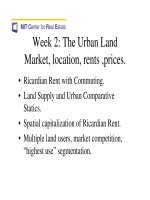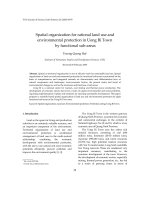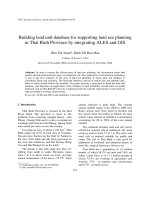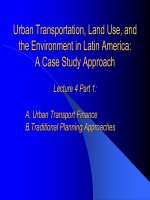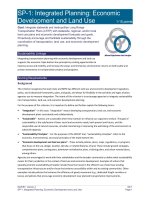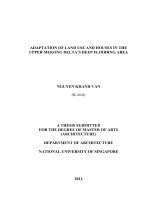sp 01 integrated planning land use and economic de
Bạn đang xem bản rút gọn của tài liệu. Xem và tải ngay bản đầy đủ của tài liệu tại đây (175.14 KB, 3 trang )
INVEST, Version 1 SP-1
SP-1: Integrated Planning: Economic Development and Land Use Page 1
SP-1: Integrated Planning: Economic
Development and Land Use 1-15 points
Goal: Integrate statewide and metropolitan Long Range
Transportation Plans (LRTP) with statewide, regional, and/or local
land use plans and economic development forecasts and goals.
Proactively encourage and facilitate sustainability through the
coordination of transportation, land use, and economic development
planning.
Sustainability Linkage
Integrating transportation planning with economic development and land use
supports the economic triple bottom line principle by creating opportunities to
improve access and mobility, and increase the social, environmental, and economic returns on both public and
private investments in transportation projects and programs.
Scoring Requirements
Background
This criterion recognizes that each state and MPO has different land use and economic development regulatory,
policy, and institutional frameworks, plans, and goals, and allows for flexibility in the activities and types of plans
agencies use to measure integration. The intent of this criterion is to encourage agencies to integrate sustainability
into transportation, land use, and economic development planning.
For the purpose of this criterion, it is important to define and further explain the following terms:
• “Integration” - In this case, “integration” means developing transportation, land use, and economic
development plans consistently and collaboratively.
• “Sustainable” - Actions are sustainable when they maintain or enhance our capacity to endure. The goal of
sustainability is the satisfaction of basic social and economic needs, both present and future, and the
responsible use of natural resources, all while maintaining or improving the well-being of the environment on
which life depends.
• “Sustainability Principles” - For the purposes of the INVEST tool, “sustainability principles” refers to the
economic, environmental, and social principles of the triple bottom line.
• “Economic development and land use plans” - These include policies, plans, maps, regulations, or programs
that focus on the use, design, location, density, or related features of land. These include growth strategies,
comprehensive plans, zoning plans, downtown revitalization plans, visioning plans, and urban renewal plans,
among others.
Agencies are encouraged to work with their stakeholders and the broader community to define what sustainability
means for their jurisdiction in the context of land use and economic development. Examples of actions that
typically promote sustainability principles include those that result in the efficient use of land near existing
transportation infrastructure and/or those that enhance accessibility within and to existing communities. Other
examples include policies that enhance the efficiency of goods movement (e.g., dedicated freight corridors or
lanes), and policies that encourage economic development near planned transportation improvements.
INVEST, Version 1 SP-1
SP-1: Integrated Planning: Economic Development and Land Use Page 2
In addition to many other widely used references and information sources, the following may be useful:
1. FHWA's Planning Tools for Linking Land Use and Transportation www.fhwa.dot.gov/planning/ppasg.htm, and
FHWA's Tool Kit for Integrating Land Use and Transportation Decision-Making
2. The Transportation Planning Process: A Briefing Book for Transportation Decision-makers, Officials, and Staff,
FHWA, Sept 2007
3. Transportation Impacts of Smart Growth and Comprehensive Planning Initiatives, NCHRP Report 25-25 Task
02, May 2004
4. Travel Model Improvement Program Clearinghouse: Land Use />Category/Land-use.aspx
5. AASHTO Center for Environmental Excellence: Land Use
6. NCHRP Report 582: Best Practices to Enhance the Transportation- Land Use Connection in the Rural United
States
Scoring
2 points. Develop and Adopt Goals and Objectives
Scoring for this requirement is based on the following, cumulative elements. The first element must be
accomplished to earn the second.
• 1 point. The agency has developed goals and objectives for the integration of metropolitan and/or statewide
transportation planning with economic development and land use planning above and beyond current
requirements. The goals and objectives further the prospects for transportation investments that support
sustainability.
• Additional 1 point. The goals and objectives are consistent with applicable economic development and land
use plans above and beyond current requirements. If existing local, metropolitan, and/or statewide economic
development and land use plans cannot be said to further sustainability principles, the agency may earn the
point by working with its partner jurisdictions to establish a joint vision for land use and economic
development within the planning area that supports sustainability principles.
3 points. Engage Partner Agencies
Scoring for this requirement is based on the following, cumulative elements. The first element must be
accomplished to earn the second.
• 2 points. The agency regularly engages land use and economic development agencies in its jurisdiction
throughout the transportation planning process, to reduce barriers and further the prospects for
implementation of its goals and objectives as identified above.
• 1 additional point. The agency utilizes institutional mechanisms (such as ad hoc or standing technical
advisory committees) to facilitate the engagement.
2 points. Use Best Practice Quantitative Methods
The agency uses best practice quantitative methods (e.g. integrated land use and transportation models) to
analyze and evaluate the performance of alternative land use/transportation scenarios. The agency incorporates
the results into the LRTP. Technical assistance and resources are available through FHWA’s Travel Model
Improvement Program, FHWA’s Toolkit for Integrating Land Use and Transportation Decision-Making, and FHWA’s
Toolbox for Regional Policy Analysis.
INVEST, Version 1 SP-1
SP-1: Integrated Planning: Economic Development and Land Use Page 3
2 points. Provide Leadership
The agency provides institutional leadership in encouraging transportation planning that is consistent with land
use and economic development plans and that supports sustainability principles. Examples include the provision of
incentives for partner jurisdictions (such as leveraging funds to provide planning grants, capital grants, model/tool
development and/or technical assistance).
6 points. Demonstrate Sustainable Outcomes
Scoring for this requirement is based on the following, cumulative elements. The first two elements must be
accomplished to earn the third.
• 1 point. The LRTP is integrated with land use and economic development plans, and the agency is
implementing transportation investments that support sustainability principles.
• 2 points. The LRTP includes sustainability-related performance measures for the integration of transportation
planning with economic development and land use planning. Examples of sustainability-related performance
measures can be found in NCHRP Report 708: A Guidebook for Sustainability Performance Measurement for
Transportation Agencies.
• 3 additional points. The agency monitors progress against the performance measures and can demonstrate
the achievement of its goals and objectives.
Scoring Sources
The program is considered to have met this criterion if the requirements above can be reasonably substantiated
through the existence of one or more of the following documentation sources (or equal where not available):
1. Adopted state or metropolitan transportation plans and supporting documentation that demonstrate how
economic development and land use goals and objectives, stakeholder input, quantitative methods, and/or
sustainability-related performance measures were integrated into the LRTP.
2. Documentation of regular land use and economic development agency engagement, and the incorporation of
their feedback into transportation planning documents. Documentation may include technical advisory
committee membership rosters, meeting agendas and minutes, and interview summaries, among others.
3. Documentation of the use of best practice quantitative tools and analysis methods that enable the evaluation
of integrated transportation, land use, and economic development scenarios.
4. The presence of statewide or metropolitan leadership and incentive programs for integrated transportation,
land use, and economic development planning (e.g., state legislation, grant programs, and/or technical
assistance, etc).
7. Documentation of the agency’s monitoring process and progress to date at meeting the agency’s goals and
objectives for integrating transportation planning with economic development and land use planning and for
implementing transportation investments that support sustainability principles.
